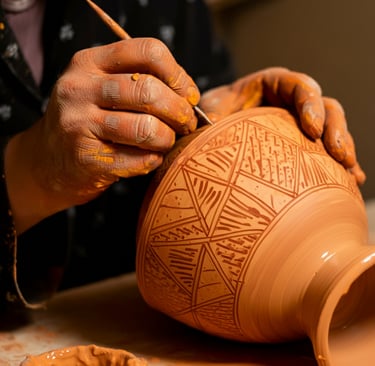Moroccan Pottery and Islamic Art
INFLUENCES & INSPIRATIONS


Moroccan pottery embodies the nation's rich artisanal legacy and visually represents its Islamic culture. For ages, Islamic art has profoundly impacted Moroccan ceramics' ornamental forms, patterns, and designs. Islamic artistic ideas exemplify geometric patterns, arabesque motifs, and calligraphy on ceramics, intertwining aesthetics with spiritual significance. These aspects embody a philosophy that underscores the boundless essence of creation and the value of beauty in quotidian existence, transforming even the most functional pottery into a medium of creative expression and cultural importance.
Islamic Art's Influence on Moroccan Ceramics
Islamic art, spanning centuries across a vast region, stands out for its emphasis on non-figurative shapes, intricate patterns, and profound meaning. This creative legacy in pottery integrated harmoniously with Morocco's indigenous Berber handicrafts, resulting in a unique ceramic style that persists today. Moroccan potters, particularly in Fez and Safi, excelled at integrating traditional Islamic art with their distinctive regional styles.
The restriction of figurative imagery in Islamic art prompted artists to investigate alternative decorative forms, including abstract patterns and motifs to represent the holy and the natural realm. Moroccan ceramics showcase geometric motifs, arabesques, and calligraphy. These components not only enhance the aesthetic appeal of the pottery but also function as a medium of spiritual expression, encapsulating fundamental tenets of Islamic philosophy.
Geometric Patterns: An Echo of the Infinite
Geometric patterns are a distinctive feature of Islamic art and integral to Moroccan ceramics. These complex patterns, often including recurring circles, triangles, and squares, represent the boundless essence of creation. Islamic philosophy views geometric patterns as a manifestation of the inherent order and harmony in the cosmos, articulating the divine essence of existence.
Moroccan ceramics often manually add geometric patterns by painting or carving into the clay surface before glazing. These patterns are observable on various ceramic objects, ranging from utilitarian bowls and plates to substantial ornamental pieces. The intricate designs exemplify the expertise of Moroccan potters, who must harmonize creative expression with technical proficiency.
The use of geometry in Moroccan pottery exemplifies the profound relationship between mathematics and art within Islamic civilization. The elaborate patterns are both visually appealing and numerically complicated, requiring precise computation and execution. The recurrence of patterns aims to evoke a sense of infinity, leading the observer's gaze into an endless cycle that reflects the eternal essence of the universe.
Arabesque Designs: The Symbiosis of Nature
The arabesque is a fundamental component of Islamic art that has significantly impacted Moroccan ceramics. This design style features sinuous, interlacing botanical elements, often evoking vines, foliage, and blossoms. In Islamic culture, the arabesque represents the interrelationship between life and the aesthetics of the natural environment. The flowing, organic forms signify the wholeness and harmony inherent in nature, demonstrating profound reverence for creation.
Moroccan clay items, such as plates and vases, often feature Arabesque designs. Usually, vivid hues like bright blues, greens, and reds render the motifs, striking a contrast with the neutral shades of the clay. The flowing curves and intricate lines of the arabesque provide a feeling of dynamism and energy, animating the ceramics.
The impact of Islamic art on Moroccan pottery is notably apparent in the use of arabesques for the surface decoration of ceramics. Islamic aesthetics fundamentally emphasize balance and symmetry through the organization of designs in circular or radial configurations. This emphasis on harmony and balance reflects both nature and the spiritual conviction that all entities are interconnected.
Calligraphy: The Craft of Written Expression
Islamic culture views calligraphy as a crucial form of creative expression that significantly influences Moroccan ceramics. Arabic calligraphy, sometimes including lines from the Quran, prayers, or lyrical expressions, embellishes ceramics, imbuing the motifs with spiritual importance. In a society that profoundly values the written word, calligraphy on pottery functions as both an artistic and a spiritual expression.
The sophistication of Arabic lettering, characterized by its fluid lines and rhythmic curves, enhances the geometric and arabesque motifs prevalent in Moroccan ceramics. Potteries often apply or inscribe calligraphy, which harmoniously integrates into the overall design. Often, designers integrate the text with geometric or floral elements to create a cohesive composition that enhances the piece's visual appeal.
exceptional calligraphy proficiency, seamlessly incorporating text into their ceramic creations, demonstrating their command of both written language and visual artistry. The use of holy texts or poetry imbues the pottery with additional significance, elevating mundane things to containers of spiritual reflection.
The Spiritual and Cultural Importance of Islamic Art in Moroccan Pottery
The amalgamation of Islamic art and Moroccan ceramics transcends simple decoration; it has profound cultural and spiritual meaning. Islamic art's abstract characteristics, which prioritize non-representational shapes and patterns, embody a perspective that views beauty as a manifestation of the divine. Moroccan artists engage in a tradition that transforms the act of creation into a spiritual exercise by integrating geometric designs, arabesques, and calligraphy into their ceramics.
The repetitive and precise designs of Moroccan ceramics reflect a feeling of discipline and commitment. Producing such elaborate patterns involves much time and expertise, and the final products exemplify the artisan's dedication to their profession. This meticulous attention to detail embodies the Islamic conviction that beauty in all aspects—be it art, architecture, or quotidian existence—mirrors the divine order of the cosmos.
Final Assessment
The influence of Islamic art on Moroccan pottery has established a profound, symbolic aesthetic that continues to define Moroccan ceramics today. The use of geometric patterns, arabesque motifs, and calligraphy elevates ordinary pottery to artistic creations imbued with cultural and spiritual significance. This amalgamation of creative traditions illustrates the profound relationship between Islamic philosophy and Moroccan handicraft, guaranteeing that pottery serves as both a functional craft and a medium for artistic expression and spiritual contemplation. Moroccan potters maintain their cultural legacy via traditional patterns, crafting timeless works that embody beauty, significance, and history.
